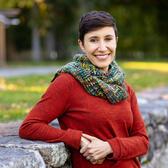Strangeness and Home, Rock and Water
On Tuesday evening, I attended a reading (co-sponsored by the Jewish Women’s Archive) by scholar/writer/activist Melanie Kaye/Kantrowitz from her new book The Colors of Jews: Racial Politics and Radical Diasporism. There’s a lot in this book—too much to discuss in one blog entry. In sum, it examines historical and contemporary views on Jews and whiteness and the complexities of African/Jewish relations. It looks at the racial mix and disparate voices of the Jewish community; contemporary Jewish anti-racist and multicultural models; and the diasporic state of Jewish life in the United States.
Much of what Melanie shared from her book focused on dismantling the assumed centrality of Ashkenazi experience in Jewish life, and accurately presenting Jews as a multi-racial, multi-ethnic people, not exclusively as "white folk" or "super whites." She read the testimonies of several Jews, who’ve witnessed racial prejudice in the Jewish community, and who are frustrated by their treatment as "exceptions" or "tokens" instead of as authentic, "normal" Jews.
I’ve read a lot of this book over the past few days, and I find what strikes me most is Melanie’s concept of Diasporism—the positive opportunity to be Jewish in non-Jewish settings; the possibility for Jewish identities to be grounded in something other than Israel, exile, the Holocaust, or religious practice; and the simultaneity of feeling at home and estranged in Jewish experience. She explains that "Diasporism demands that we mix it up in ways that we don’t even know yet… if we are at an event that claims to be for the whole Jewish community, at any given moment something must feel unfamiliar to someone; it shouldn’t always be the same people; Diasporism means letting go of some familiarity and welcoming some dissonance."
I like this Diasporism (I don’t think it is anti-Zionist, or at all antithetical to life in Israel), and in learning about it, I was reminded of a few truly "diasporic" experiences I’ve had: praying with an Iraqi minyan and feeling like a noticeable outsider while confronted with an unfamiliar permutation of sexism; living in Poland—which is far more white than the U.S.—where I encountered "Catholic Jews"; and hearing a black-Jewish choir perform among an almost exclusively Ashkenazi audience. I don’t know what to do with all of this, but Melanie’s description that "Jewish identity is simultaneously rock, forged under centuries of pressure, and water, infinitely flexible" makes some sense to me, and makes me want to continue living in and between this strangeness and the sense of home.
What I’m learning more and more, is that Jewishness is wonderfully chaotic and messy, and will probably only get messier; that racial and cultural realities among Jews are always shifting, too complicated to be categorized, ignored, or used as a ploy for political correctness; and that, as Judith Plaskow wrote, "we’re not the generation that gets to feel comfortable." If this is true—and I think it is—how can we draw closer to understanding who we are and how we’re perceived, without tipping the scale of what's familiar and what's dissonant too far in one direction?






